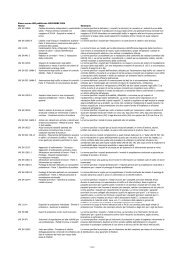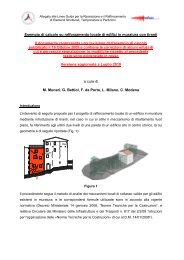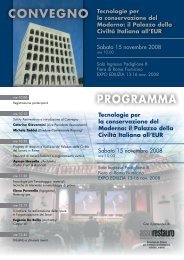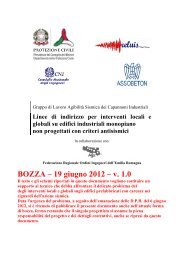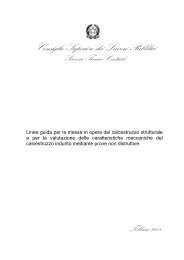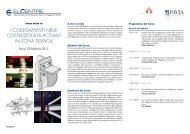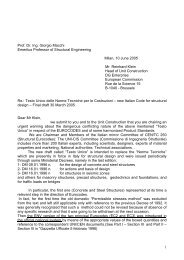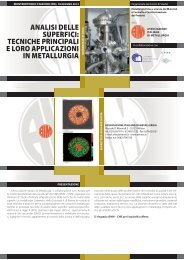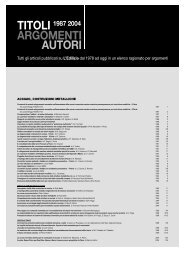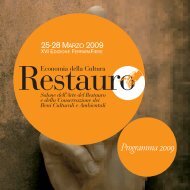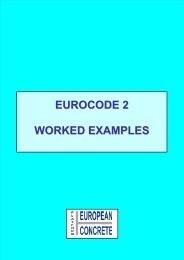Combinazioni di Verifica agli stati Limite: il non ... - Steelchecks.com
Combinazioni di Verifica agli stati Limite: il non ... - Steelchecks.com
Combinazioni di Verifica agli stati Limite: il non ... - Steelchecks.com
Create successful ePaper yourself
Turn your PDF publications into a flip-book with our unique Google optimized e-Paper software.
10<br />
azione variab<strong>il</strong>e possa avere un valore quasi permanente <strong>non</strong> nullo, dato che essa è “variab<strong>il</strong>e” può<br />
anche darsi che <strong>non</strong> ci sia, cosa che, lo riba<strong>di</strong>amo, è esclusa dalla (2) a causa del γ q =1 a fattor<br />
<strong>com</strong>une.<br />
Infatti un conto è valutare <strong>il</strong> valore quasi permanente <strong>di</strong> un’azione che può variare nel<br />
tempo, stab<strong>il</strong>endo con ciò <strong>il</strong> valore <strong>non</strong> nullo più probab<strong>il</strong>e che si possa assumere <strong>com</strong>e “quasi<br />
permanente”, un conto è sostenere che <strong>non</strong> vi sono r<strong>il</strong>evanti intervalli <strong>di</strong> tempo nei quali essa è<br />
nulla. Sono due cose nettamente <strong>di</strong>verse. In effetti, per fare uno degli innumerevoli esempi possib<strong>il</strong>i,<br />
<strong>di</strong> notte e <strong>di</strong> sera i carichi variab<strong>il</strong>i negli uffici <strong>non</strong> ci sono, ed un sisma può ben avvenire <strong>di</strong> notte,<br />
no I teatri al mattino sono vuoti. Gli sta<strong>di</strong> nei giorni feriali sono vuoti. I carichi variab<strong>il</strong>i avranno<br />
pure un valore “quasi permanente” pari a 0.3 volte <strong>il</strong> valore caratteristico, ma per la metà del tempo<br />
(o più) <strong>non</strong> ci sono affatto. La metà del tempo o più.<br />
Pertanto a parere <strong>di</strong> chi scrive la (2) dovrebbe essere corretta <strong>com</strong>e segue:<br />
ng<br />
∑<br />
i=<br />
1<br />
G<br />
ik<br />
nq<br />
∑<br />
+ γ E + ( γ ψ Q ) (2bis)<br />
Ia<br />
a<br />
i=<br />
1<br />
qi<br />
2i<br />
ik<br />
con la specificazione che “γ qi può assumere <strong>il</strong> valore 0 o 1 a seconda <strong>di</strong> quale situazione<br />
risulti in<strong>di</strong>vidualmente peggiore per la struttura”.<br />
2.4 Esempi a confutazione delle formule <strong>di</strong> normativa<br />
2.4.1 Stati limite ultimi<br />
Nel seguente semplice esempio si vede <strong>com</strong>e <strong>il</strong> mettere a fattore <strong>com</strong>une <strong>il</strong> γ q porti a<br />
pericolose sottostime delle azioni interne, leggib<strong>il</strong>i invece con la formula corretta che prevede <strong>di</strong><br />
<strong>non</strong> mettere a fattor <strong>com</strong>une γ q .<br />
Abbiamo (fig. 4) un semplice portale alto 4m, luce <strong>di</strong> 4m e sbalzo <strong>di</strong> 2m. Le colonne<br />
sono in Rck250 30x30cmq, le travi sono 30x45cmq. I carichi permanenti (P) siano modellati con un<br />
carico uniforme <strong>di</strong> 20KN/m=20N/mm. Siano presenti tre carichi variab<strong>il</strong>i:<br />
1. Q 1 un carico uniforme <strong>di</strong> 30N/mm su tutto <strong>il</strong> traverso;<br />
2. Q 2 un carico appeso all’estremità dello sbalzo e pari a 30000N;<br />
3. Q 3 un carico <strong>di</strong>stribuito pari a 8N/mm (ad esempio <strong>il</strong> vento).<br />
Paolo Rugarli – <strong>Combinazioni</strong> <strong>di</strong> <strong>Verifica</strong> <strong>agli</strong> <strong>stati</strong> <strong>Limite</strong>: <strong>il</strong> <strong>non</strong> detto delle Normative



